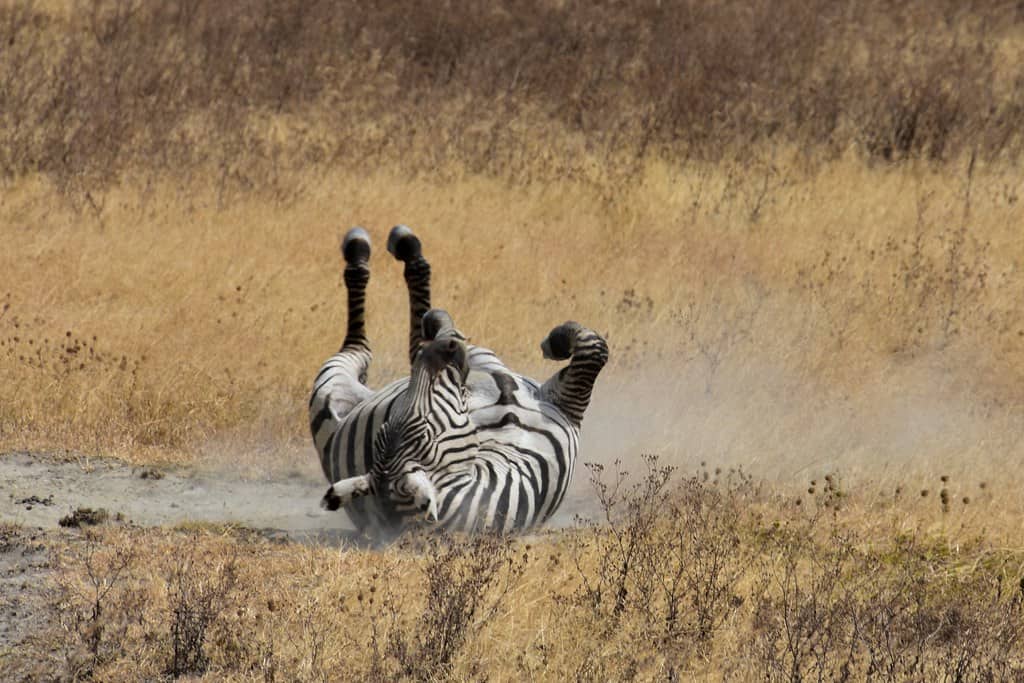Across the vast savannas and grasslands of Africa, zebras engage in a behavior that might seem peculiar to casual observers but serves multiple critical functions for their survival and wellbeing. Rolling in dust and mud is not merely a playful activity for these striped equids but rather a sophisticated behavioral adaptation that has evolved over millennia. This seemingly simple action helps zebras combat various environmental challenges, from pesky parasites to scorching African heat. By understanding why zebras roll in dust and mud, we gain deeper insights into the complex relationship between these iconic animals and their environment, as well as the remarkable ways wildlife has adapted to thrive in challenging conditions.
The Natural Instinct Behind Rolling Behavior
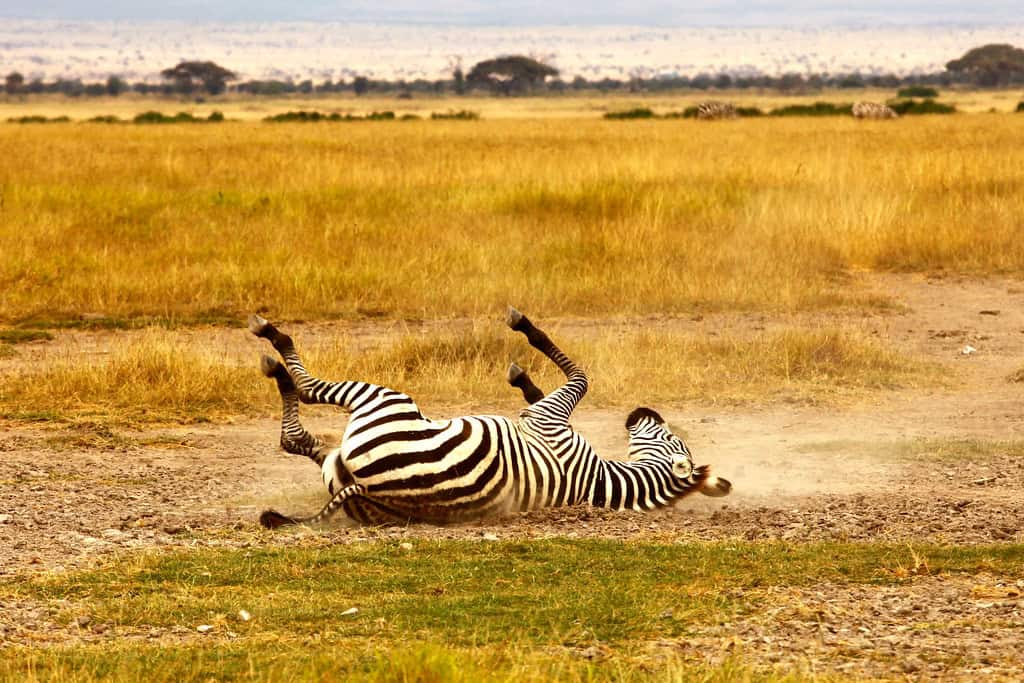
Zebras, like many equids including horses and donkeys, possess an innate instinct to roll in dust and mud. This behavior is so deeply ingrained that it appears in zebras of all ages and across all three zebra species – the plains zebra (Equus quagga), mountain zebra (Equus zebra), and Grevy’s zebra (Equus grevyi). Young foals begin displaying this rolling behavior within their first few weeks of life, learning partly through observation of adult herd members.
Evolutionary biologists believe this rolling behavior evolved as a multi-purpose survival mechanism. The action isn’t random – zebras typically select specific locations for their dust baths, often returning to the same rolling spots repeatedly. These “rolling sites” are usually characterized by fine, dry soil or sand in the case of dust baths, or muddy depressions near water sources for mud wallowing. The instinct is so powerful that captive zebras in zoos and wildlife sanctuaries continue to perform this behavior even when some of its wild survival benefits may no longer be necessary.
Protection Against Biting Insects

One of the primary reasons zebras roll in dust and mud is to defend themselves against the constant onslaught of biting insects that plague the African plains. Flies, mosquitoes, tsetse flies, and ticks are not merely annoying – they can transmit dangerous diseases like African horse sickness, equine infectious anemia, and various forms of trypanosomiasis. By coating their bodies with a layer of dust or dried mud, zebras create a physical barrier that makes it harder for these insects to reach their skin.
Research has shown that the dried mud layer specifically disrupts the ability of biting flies to pierce the zebra’s skin with their proboscis. Additionally, the scent of the mud or dust may mask the zebra’s natural body odor, which insects use to locate potential hosts. During peak insect seasons, zebras have been observed increasing the frequency of their rolling behavior, sometimes dust-bathing multiple times daily. This adaptation is particularly crucial in regions where disease-carrying insects are prevalent, giving zebras a vital edge in their ongoing battle against these tiny but dangerous foes.
Natural Sunscreen Properties
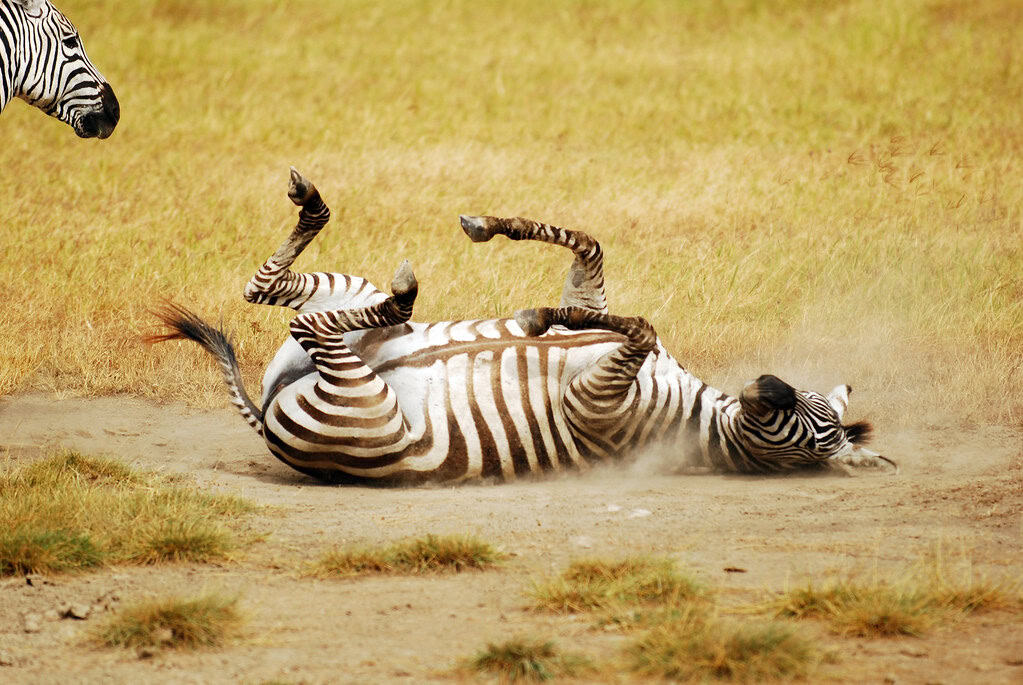
The harsh African sun presents another significant challenge for zebras. With surface temperatures on the savanna regularly exceeding 120°F (49°C), zebras face potential sunburn and heat stress daily. The layer of mud or dust that coats a zebra’s back after rolling serves as a natural sunscreen, reflecting some of the sun’s rays and providing a measure of protection against UV radiation. This is especially important for zebras, as their skin, despite being dark underneath their distinctive stripes, can still suffer damage from prolonged sun exposure.
Field observations have documented that zebras tend to increase their mud-rolling behavior during the hottest periods of the day and in the most arid seasons, suggesting this behavior has a thermoregulatory function. The mud coating, in particular, adds another cooling mechanism – as the mud dries, it draws heat away from the body through evaporative cooling, similar to how sweating works in humans. Some studies estimate that a good mud coating can reduce a zebra’s surface body temperature by as much as 5-10°F (3-5.5°C), providing valuable relief during the hottest parts of the day.
Parasite Management and Skin Health
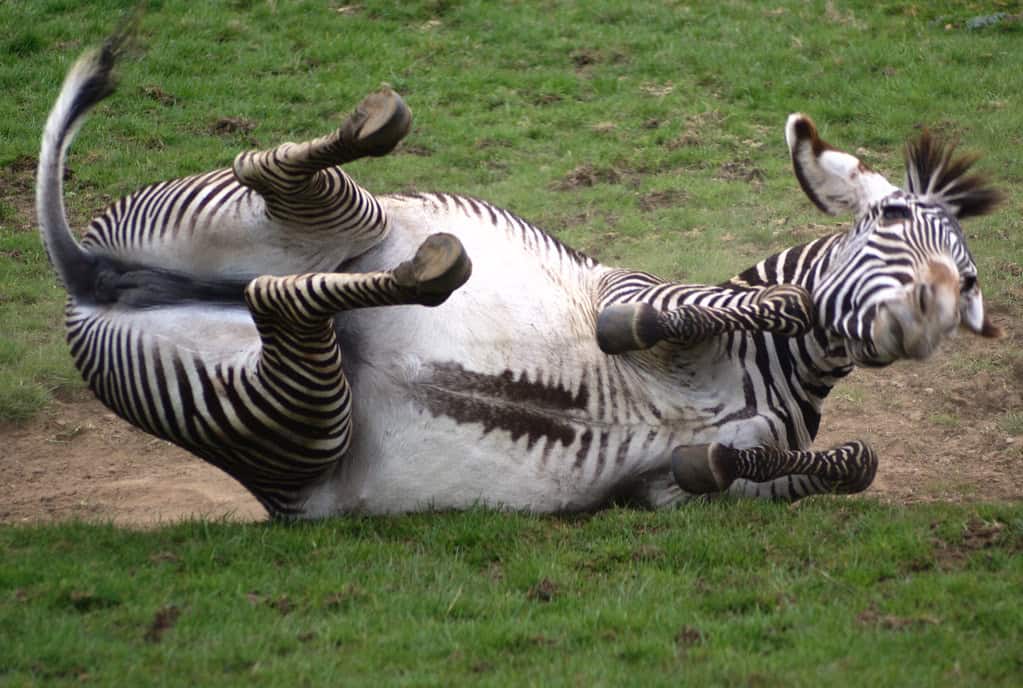
Beyond flying insects, zebras contend with a variety of external parasites that can take up residence in their skin and hair. Mites, lice, and various fungi can all compromise a zebra’s health if left unchecked. The abrasive nature of dust and sand particles helps zebras physically scrape away these parasites during the rolling process. The vigorous rolling motion, which often includes side-to-side movements and back-and-forth rocking, creates a scrubbing effect that dislodges parasites from hard-to-reach areas of the zebra’s body.
Certain types of mud, particularly those rich in minerals, may also have mild antiseptic properties that help prevent skin infections. When zebras roll in mud that contains sulfur compounds or certain clay minerals, these substances can help soothe existing skin irritations and create an environment less hospitable to fungal growth. Zoologists have observed that zebras with access to mud baths typically display healthier skin and coat conditions than those without such access, highlighting the importance of this behavior for overall skin health maintenance in the wild.
Social Significance Within Zebra Herds
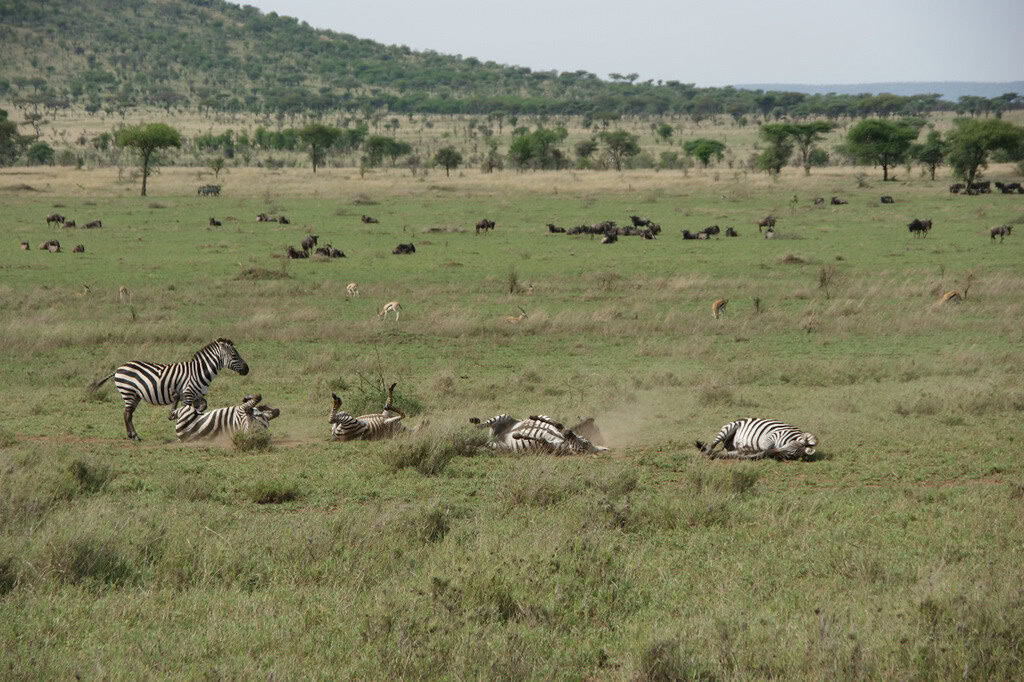
Rolling behavior in zebras also carries social significance within their complex herd structures. When one zebra begins rolling, it often triggers a chain reaction, with multiple herd members taking turns at the same rolling spot. This synchronized behavior strengthens social bonds and allows for communal protection, as more eyes remain alert for predators while individuals take turns rolling. Researchers have noted that dominant zebras typically have priority access to preferred rolling sites, with subordinate herd members waiting their turn.
The shared use of rolling sites also facilitates the transfer of beneficial soil bacteria among herd members, potentially contributing to a form of social immunity within the group. Additionally, the mutual engagement in this behavior may help distribute information about quality dust or mud locations among the herd. Young zebras learn appropriate rolling techniques and locations by observing experienced adults, making this behavior part of the essential knowledge transferred from generation to generation within zebra societies.
Seasonal Variations in Rolling Behavior
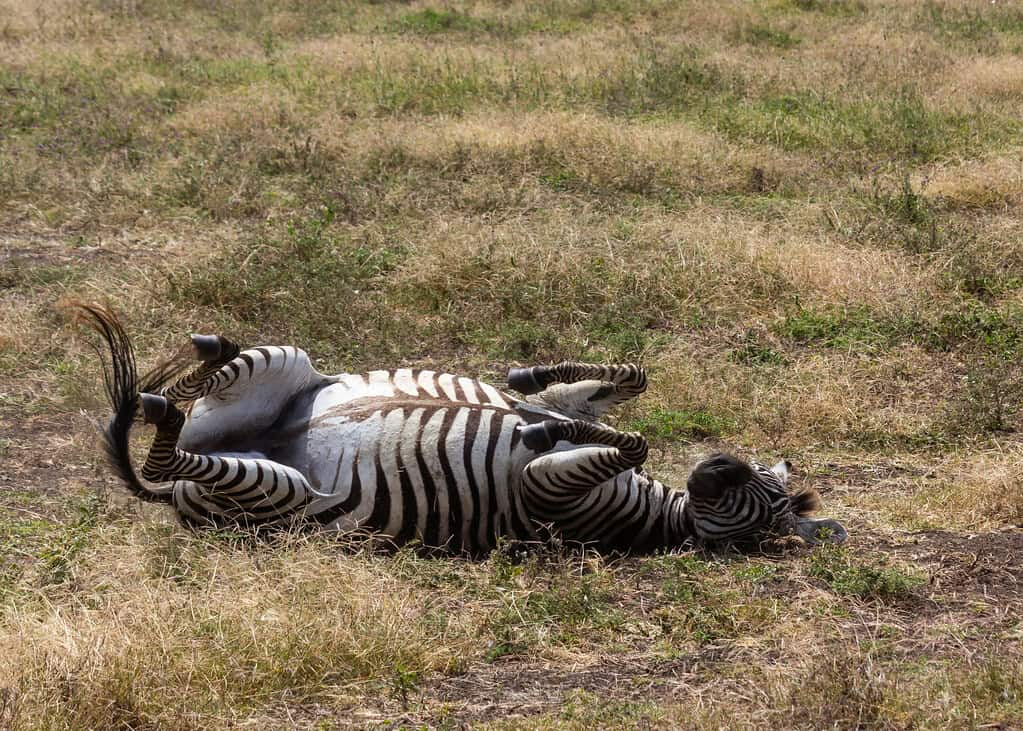
Zebras adjust their rolling behaviors according to seasonal changes in their environment. During the dry season, when dust is abundant and water sources are limited, dust-bathing predominates. These dry-season dust baths are typically taken during the cooler parts of the day, often in early morning or late afternoon, when the fine dust particles can best adhere to the zebras’ bodies. The consistency and frequency of these dust baths help zebras maintain their defenses against parasites even when water for mud wallowing is scarce.
Conversely, during the wet season, when mud is readily available, zebras shift predominantly to mud wallowing. This seasonal adaptation allows them to take advantage of the superior cooling properties and longer-lasting protection that mud provides. Field studies in Kenya’s Masai Mara have documented that zebras may travel several kilometers out of their way to visit particularly favored mud wallows after seasonal rains have filled these depressions. This seasonal flexibility in rolling behavior demonstrates the zebra’s remarkable ability to adapt their self-maintenance routines to changing environmental conditions.
The Cooling Effect of Mud Wallowing
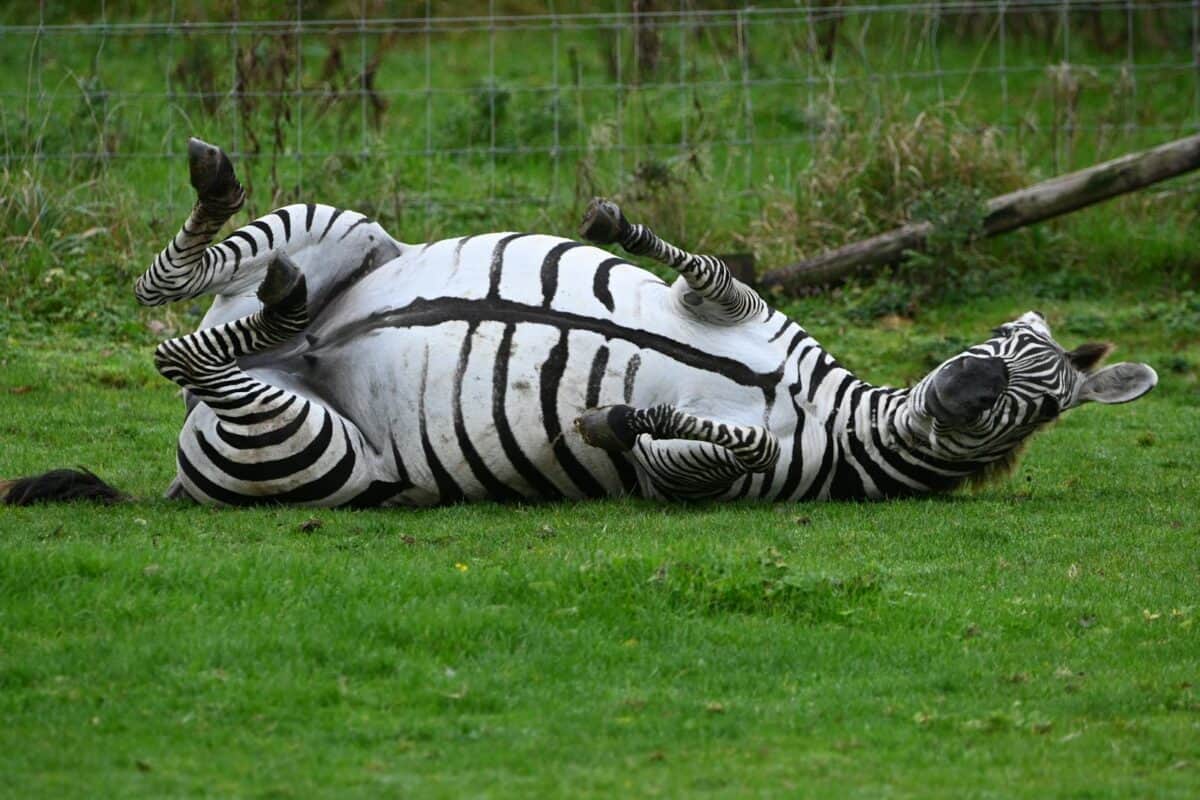
While both dust and mud provide benefits to zebras, mud wallowing offers superior cooling properties that become especially valuable during intense heat. When zebras cover themselves in wet mud, they essentially create a personal evaporative cooling system. As the water in the mud gradually evaporates from the zebra’s body, it draws heat away from the skin, helping to regulate the animal’s core temperature. This cooling effect can last for several hours, providing extended relief during the hottest parts of the day.
Thermal imaging studies of zebras before and after mud wallowing have revealed temperature drops of up to 15°F (8.3°C) on the surface of their bodies. This significant cooling effect helps zebras conserve energy that would otherwise be expended on biological cooling mechanisms like sweating. For zebras inhabiting particularly hot regions, such as Tanzania’s Serengeti during the dry season, mud wallowing becomes not merely beneficial but essential for preventing potentially fatal heat stress. The strategic timing of mud wallows, often in late morning before peak heat, demonstrates how zebras have optimized this behavior to maximize its cooling benefits.
Differences in Rolling Behavior Among Zebra Species

Interesting variations in rolling behavior exist among the three zebra species, reflecting their adaptation to different habitats. Plains zebras, which inhabit open grasslands with abundant water holes, typically engage in frequent mud wallowing when possible. They often perform elaborate rolling sequences, sometimes spending up to 15 minutes at a time engaged in the activity. Their rolling sites are frequently located near watering holes, allowing them to combine drinking, mud wallowing, and social interaction in a single location.
In contrast, mountain zebras, adapted to more arid and rocky environments, rely more heavily on dust bathing. Their rolling technique tends to be more vigorous, possibly to compensate for the reduced availability of mud. The endangered Grevy’s zebra, which inhabits the driest environments of the three species, has developed highly efficient dust-bathing techniques that require minimal moisture. They often create personal dust bowls by pawing at the ground before rolling, demonstrating how this behavior has been refined differently across zebra species to match their specific environmental challenges.
The Role of Rolling in Zebra’s Stripe Maintenance
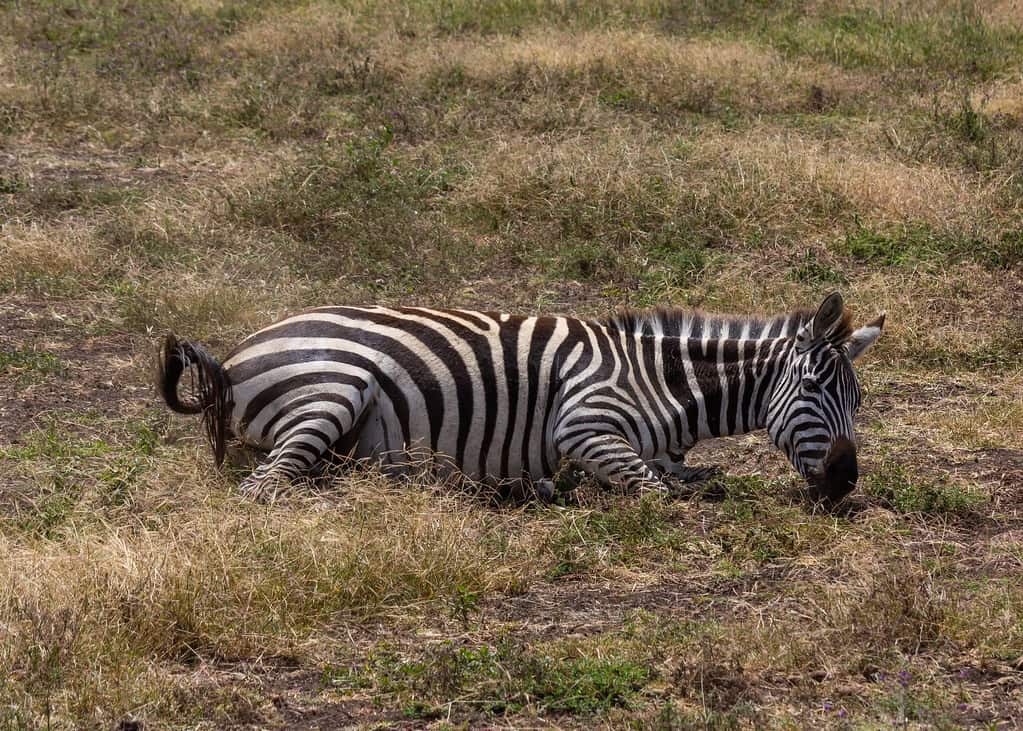
The iconic black and white stripes of zebras serve multiple purposes, from predator confusion to temperature regulation. Rolling in dust and mud plays a surprising role in maintaining the visual impact of these stripes. The contrast between black and white stripes can be enhanced when fine dust particles settle differently on the varying surfaces of the zebra’s coat. The dust tends to adhere more effectively to the slightly oilier black stripes, while more easily falling away from the white stripes, temporarily increasing the visual contrast of the pattern.
Additionally, the abrasive action of rolling helps remove dead skin cells and old hair, promoting healthier coat growth that displays the stripe pattern more vividly. Research conducted at the University of California, Davis, suggests that well-maintained stripes may be more effective at deterring biting flies, which appear to have difficulty landing on surfaces with high-contrast patterns. By enhancing their stripe definition through regular rolling, zebras may be inadvertently improving one of their key defense mechanisms against biting insects.
Comparison with Other Equids and Mammals
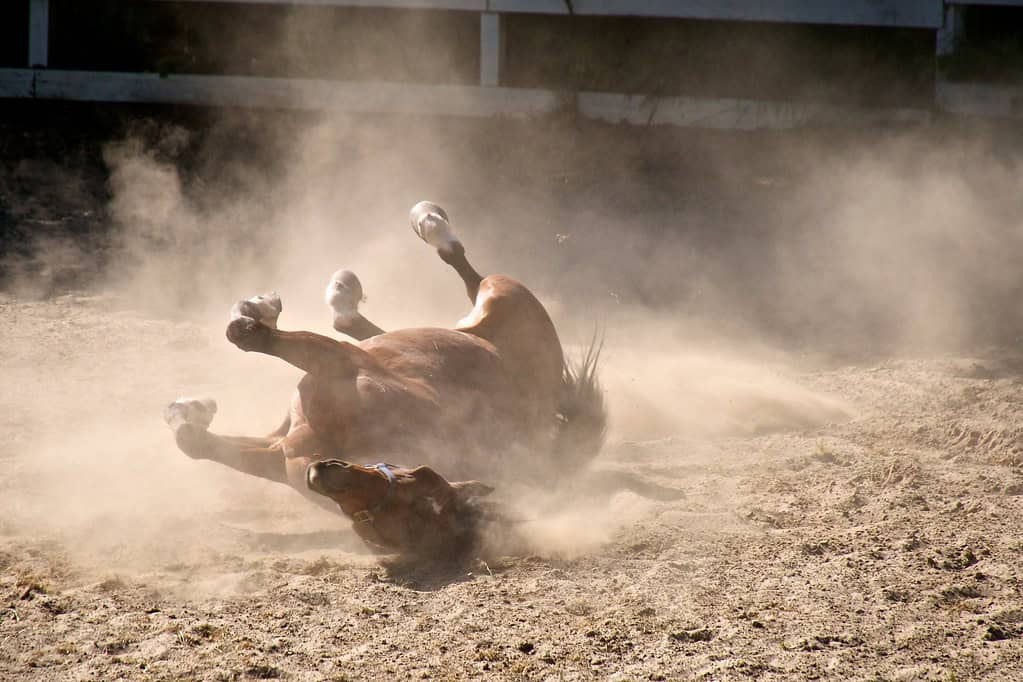
Rolling behavior isn’t unique to zebras – it appears across the equid family and many other mammal species, though with interesting variations. Wild horses and donkeys engage in similar dust and mud rolling, though typically with less frequency than zebras. This difference likely reflects the more extreme parasite pressures and heat challenges in zebra habitats. Rhinos and elephants take mud wallowing to another level, often submerging large portions of their bodies directly in mud pools rather than just rolling.
Even predators like lions and hyenas occasionally engage in dust rolling, though primarily for parasite management rather than heat regulation. What makes zebra rolling behavior particularly noteworthy is its frequency and elaborateness. A healthy adult zebra may roll up to five times daily during peak insect seasons, far more frequently than most other equids. The behavior is so important to zebras that wildlife veterinarians and zookeepers now recognize that providing appropriate rolling substrates is a critical component of zebra welfare in captivity, necessary for both their physical and psychological health.
How Rolling Affects Zebra Movement Patterns

The need for suitable rolling locations influences zebra migration and movement patterns in significant ways. Researchers tracking zebra herds have discovered that access to quality dust or mud wallowing sites factors into their decision-making about grazing routes and water source selection. During migration, zebras have been observed making detours of several kilometers to visit particularly favored rolling locations, especially after seasonal rains have created ideal mud conditions.
These rolling sites become important landmarks in zebra territories and migration routes, passed down through generations of herds. Some well-established wallowing locations show evidence of use stretching back decades, with distinct depressions formed in the landscape from countless zebra rolls. During drought conditions, when water becomes scarce, conflict between different zebra herds can sometimes arise over access to the remaining mud wallowing locations. This willingness to expend valuable energy to reach specific rolling sites underscores just how essential this behavior is to zebra well-being and survival in the wild.
Far from being a simple quirk of behavior, rolling in dust and mud represents a sophisticated survival adaptation that helps zebras thrive in challenging environments. This multifunctional behavior simultaneously addresses parasite defense, temperature regulation, skin health, and social cohesion – all critical aspects of zebra survival. The variations in rolling techniques across different zebra species and the seasonal adjustments they make highlight the remarkable behavioral plasticity that has evolved in these iconic African mammals.
Understanding why zebras roll provides valuable insights for conservation efforts, particularly as climate change alters traditional habitats and potentially impacts the availability of suitable rolling substrates. For wildlife managers and zoologists, recognizing the importance of this behavior has led to improved captive care practices and a deeper appreciation of the complex relationship between zebras and their environment. As with so many seemingly simple animal behaviors, zebra rolling reveals layers of evolutionary wisdom that remind us how thoroughly adapted wild animals are to their natural circumstances, and how even actions that appear playful often serve profound survival purposes.
- Why Zebras Roll in Dust and Mud - August 9, 2025
- America’s Most Endangered Mammals And How to Help - August 9, 2025
- The Coldest Town in America—And How People Survive There - August 9, 2025

